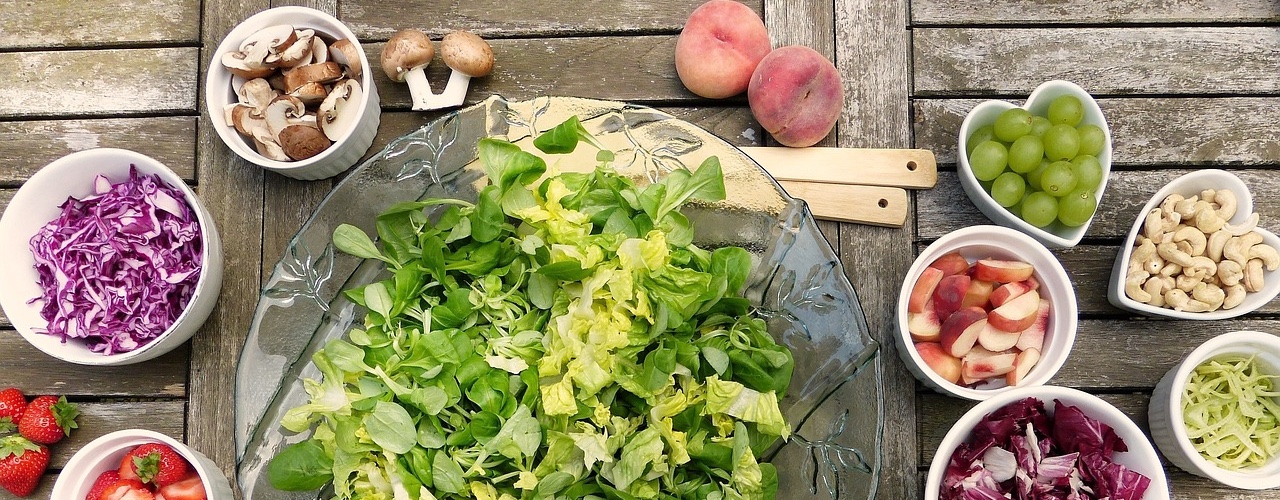If you’re interested in improving your diet, but you’re not quite ready to go completely plant-based, here are five simple ways to boost your plant intake and improve your overall health. Adopt all five or choose strategies that are realistic for you and your lifestyle. Remember that the goal is to make successful, sustainable changes, not sacrifices. We want you to look forward to meals and snacks and enjoy healthful eating.
1. Eat more veggies.
Eating more veggies may seem obvious but try to make this goal “SMART” (Specific, Measurable, Attainable, Relevant, and Time-Bound) rather than vague. Here are some specific examples of what a SMART veggie goal may look like:
- Eat one vegetable at every meal.
- Eat three different types of vegetables every day.
- Try one new vegetable every week.
- Eat a salad before dinner daily.
- Plan meals around vegetables, not meat, and make the veggie the star of the show.
- Fill half of every plate with vegetables at least two times per day.
If you don’t eat many vegetables now, start with smaller portions and work your way up. Also, feel free to surpass the amounts in the example goals.
Vegetables provide health protective micronutrients as well as fiber. Fiber helps regulate blood sugar, promotes bowel regularity and a healthy gut, and supports weight management. If you don’t currently consume many fiber sources (fruits, vegetables, legumes, or whole grains), add fiber to your diet gradually to allow your digestive system to adjust, and be sure to drink plenty of water.
2. Eat more plant-based protein.
Plant-based proteins include black beans, chickpeas, lentils, edamame, tofu, tempeh, nuts, seeds, and more. Work towards replacing at least one source of animal protein with a plant-based option each day.
Try swapping your morning eggs for a breakfast scramble made from tofu or chickpeas. Opt for a hummus, veggie, and avocado wrap for lunch instead of a meat and cheese sandwich or replace ground beef with beans or lentils on taco night. These simple swaps don’t require drastic changes to your diet, but they can significantly benefit your health.
Plant-based proteins provide fiber, antioxidants, and micronutrients, and replacing animal protein with plant protein is linked to improved longevity.
3. Trade refined grains for whole grains.
Whole grains contain vitamins, minerals, antioxidants, and fiber. Fiber supports bowel regularity and improvements in weight, cholesterol, and blood sugar levels. A higher fiber intake is also linked to a reduced chronic disease risk and improved life span.
Replacing refined grains with whole grains is one simple way to improve your overall diet. Whole grains include brown rice, barley, millet, whole grain pasta, quinoa, oatmeal, whole grain bread, farro, whole grain crackers, and whole grain tortillas. Here are some examples of what a SMART whole grain goal may look like:
- Consume one whole grain source daily, such as oats at breakfast.
- Consume one whole grain source at each meal, such as oats at breakfast, quinoa at lunch, and brown rice at dinner.
- Swap out two refined grain products you regularly consume for whole grain alternatives (examples: swap out white bread for 100% whole grain bread and replace white flour crackers with 100% whole grain crackers).
- Buy one new whole grain option each time you grocery shop.
4. Drink more water and less sugary beverages.
Simply drinking enough water each day can offer tremendous health benefits. But swapping out sugary drinks for water can seriously upgrade your health. Sugary drinks add surplus calories without providing any nutritional value, and a high intake of added sugar increases health risks. Water helps your body function properly and replacing sugary drinks with water can improve your overall energy levels and support circulation and digestive health.
The goal is to consume at least eight cups of water daily. Here are some examples of ways to reach this goal:
- Keep a water bottle nearby while you work (such as at your desk) to sip on throughout the day.
- Attach water to a frequent action. For example, take a sip every time you stand up, check your phone, or send an email.
- Drink a glass of water before or during every meal.
- Set timed, individual goals throughout the day, such as having three glasses of water before lunch. Note: you can purchase large water bottles with pre-marked goals and timelines.
- Add flavor to your water naturally with infusions of fresh fruit, herbs, or cucumber.
5. Optimize your snacks.
Snacking can be a smart way to tide you over between meals, so you don’t get overly hungry. Healthy snacks can also help you take in more nutrients and regulate blood sugar, insulin, and energy levels.
Instead of swearing off snacks, optimize them. Choose whole or very minimally processed foods over ultra-processed choices and try to include a protein source to feel fuller and more energized. For example, instead of peanut butter crackers enjoy a sliced apple dipped in all-natural peanut butter. Rather than chips, try whole grain crackers or raw veggies with hummus.
Optimizing your snacks can improve your overall nutrient intake, elevate your energy level, and prevent overindulging at your next meal.
Additional examples of whole food, optimized snacks with protein include:
- Fresh or dried fruit + nuts
- Energy balls made with nut butter + oats and dried fruit
- A fruit smoothie + flax/chia/hemp seeds
- Granola + plant-based yogurt (with at least five grams of protein)
- Roasted chickpeas
- Edamame
- Fruity chia seed pudding
- Overnight oats + nuts/seeds
Get more expert advice on how to feel better for good. Sign up for our newsletter here.

